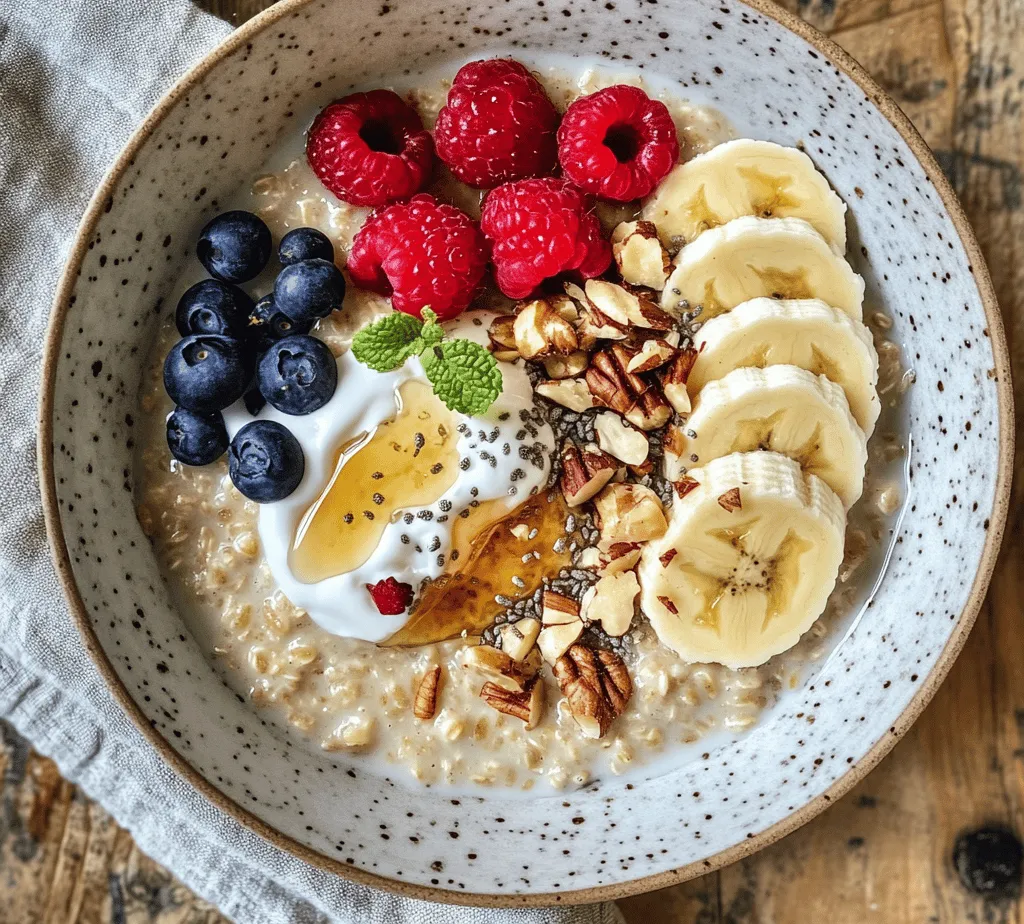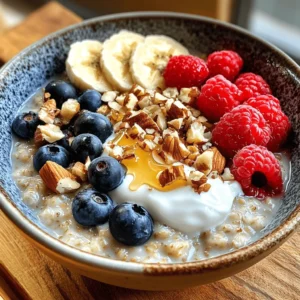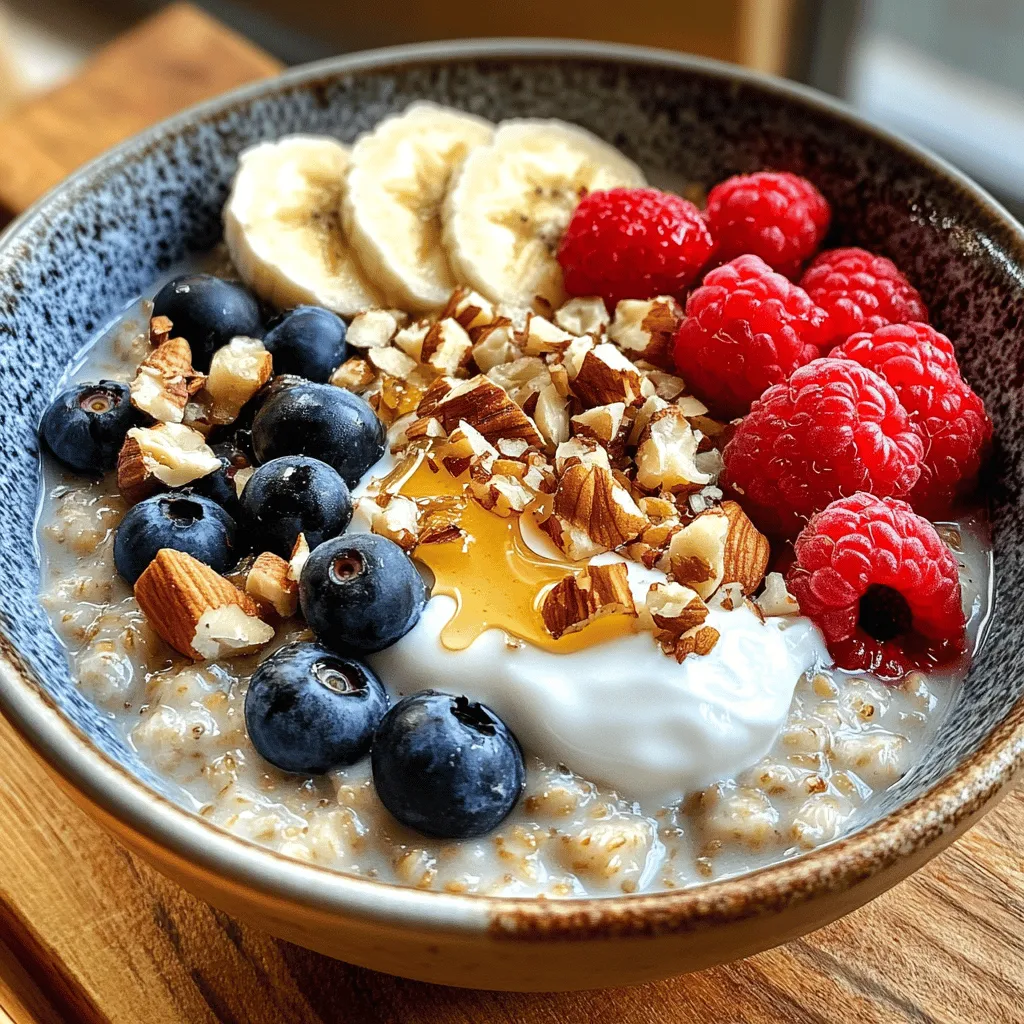Begin your day with a hearty and nutritious breakfast that warms the soul: Creamy Barley Porridge Delight. This dish is not only rich in flavor but also packed with health benefits, thanks to its main ingredient, pearl barley. As a versatile grain, barley is known for its ability to keep you full and satisfied, making it an excellent choice for a wholesome breakfast. In this article, we will explore everything you need to know to prepare this delightful porridge, including its nutritional benefits, preparation steps, and creative serving suggestions.
Understanding Pearl Barley
Pearl barley, the star of this recipe, is a whole grain that has been processed to remove its outer hull and bran layer, resulting in a smooth, pearl-like appearance. Unlike refined grains, pearl barley retains some of its nutritional value, making it an excellent choice for a wholesome breakfast option.
Nutritional Profile of Pearl Barley
One of the standout features of pearl barley is its impressive nutritional profile. Here’s a closer look at the benefits of incorporating this grain into your breakfast routine:
– High Fiber Content: Pearl barley is rich in soluble and insoluble fiber, which can significantly improve digestive health. The soluble fiber helps to regulate blood sugar levels and lowers cholesterol, while the insoluble fiber aids in maintaining bowel regularity. This combination not only keeps you full longer but also promotes overall gut health.
– Vitamins and Minerals: This grain is packed with essential vitamins and minerals, including B vitamins (like niacin and thiamine), which are crucial for energy metabolism, and minerals such as iron, magnesium, and selenium. These nutrients play vital roles in maintaining a healthy body and can help reduce the risk of chronic diseases.
– Comparison with Other Grains: When compared to other popular grains like oats and quinoa, pearl barley stands out due to its lower glycemic index. This means it releases energy more slowly, preventing spikes in blood sugar levels. Additionally, pearl barley is often less expensive than quinoa and offers a unique nutty flavor that complements a variety of toppings and flavors.
Historical Significance of Barley
Barley has a rich history that dates back thousands of years. It is one of the oldest cultivated grains in the world, with evidence of its use found in ancient Egyptian tombs. Historically, barley was not only a staple food source but also held significance in various cultures:
– Origins and Traditional Uses: Barley has been consumed for millennia, originally cultivated in the Middle East before spreading to Europe and Asia. In ancient times, it was often ground into flour for bread or used in porridge, making it a significant part of the diet for many civilizations. Additionally, barley was used in brewing beer, a practice that dates back to ancient Mesopotamia.
– Barley in Modern Diets and Culinary Practices: Today, barley is enjoying a resurgence in popularity as more people recognize its health benefits. It is commonly used in soups, stews, salads, and, of course, porridge. In many cultures, barley is celebrated for its versatility, and it is often featured in traditional dishes around the world.
Ingredients Breakdown for Creamy Barley Porridge
Before diving into the preparation of Creamy Barley Porridge Delight, it’s essential to understand the ingredients that make this dish not only delicious but also nutritious. Here’s a detailed look at each ingredient:
Pearl Barley: Varieties and Selection Tips
When selecting pearl barley, look for high-quality grains that are free from debris or discoloration. There are two primary types of barley you may come across: hulled barley and pearl barley. While hulled barley retains its bran and has a chewier texture, pearl barley is more refined and cooks faster, making it an ideal choice for porridge.
Water vs. Vegetable Broth: Flavor Enhancement and Nutritional Benefits
The choice of liquid is crucial in preparing this porridge. While water will yield a neutral flavor, using vegetable broth can elevate the taste profile of the dish. Broth adds depth and complexity, enhancing the overall flavor of the porridge without adding excessive calories. Additionally, vegetable broth can provide extra vitamins and minerals, making your meal even more nutritious.
Dairy vs. Non-Dairy Milk: Pros and Cons of Each Option
For a creamy texture, you can choose between dairy milk or non-dairy alternatives. Dairy milk offers a rich flavor and additional protein, while non-dairy options such as almond, oat, or coconut milk can cater to lactose-intolerant individuals or those following a vegan diet. Each type of milk has its unique flavor and nutritional profile, so choose based on your dietary preferences and desired taste.
Natural Sweeteners: Honey vs. Maple Syrup and Their Health Implications
Sweetening your porridge can take it to the next level. Natural sweeteners such as honey and maple syrup are popular choices. Honey is known for its antioxidant properties and can provide a quick energy boost, while maple syrup is rich in minerals like manganese and zinc. When using sweeteners, it’s essential to remember that moderation is key, as these can add extra calories.
Flavor Enhancers: The Role of Vanilla Extract, Salt, and Cinnamon in the Recipe
A few simple ingredients can make a significant difference in the flavor of your creamy barley porridge. Vanilla extract adds a warm, aromatic note, while a pinch of salt can enhance the overall taste. Cinnamon, known for its anti-inflammatory properties, not only adds sweetness but also provides a comforting flavor that pairs beautifully with barley.
Nuts and Fruits: Nutritional Benefits and Ideal Pairings for Topping
To finish off your Creamy Barley Porridge Delight, consider adding a variety of nuts and fruits. Nuts such as almonds, walnuts, or pecans provide healthy fats and protein, while fruits like bananas, berries, or apples add natural sweetness and a burst of vitamins. These toppings not only enhance the dish’s nutritional value but also make it visually appealing.
Step-by-Step Instructions for Preparation
Now that we have a solid understanding of the ingredients, let’s get started with the preparation of your Creamy Barley Porridge Delight. Follow these steps for a delicious and satisfying breakfast.
Rinsing the Barley
Before cooking, it’s important to rinse the pearl barley under cold running water. Rinsing helps to remove any residual dust or impurities and can also enhance the texture of the final dish. By washing the grains, you ensure that they cook evenly and absorb flavors better during the cooking process.
Cooking the Barley
You can choose between two primary cooking methods for your barley porridge: stovetop and slow cooker. Here’s a breakdown of both methods:
– Stovetop Method: In a medium saucepan, combine the rinsed barley with the chosen liquid (water or vegetable broth) in a 1:3 ratio of barley to liquid. Bring the mixture to a boil, then reduce the heat to low and cover. Let it simmer for about 30-40 minutes, stirring occasionally, until the barley is tender and creamy. If you prefer a thicker porridge, reduce the liquid slightly or cook it for a longer duration.
– Slow Cooker Method: For a hands-off approach, you can use a slow cooker. Combine the rinsed barley with your chosen liquid in the slow cooker. Set it on low for 6-8 hours or on high for 3-4 hours. This method is perfect for preparing breakfast overnight, allowing you to wake up to a warm and comforting porridge ready to be enjoyed.
By following these steps, you’ll be well on your way to creating a delicious and nutritious Creamy Barley Porridge Delight that not only satisfies your hunger but also fuels your body with essential nutrients. Stay tuned for the next part to explore serving suggestions and expert tips for the perfect bowl of porridge.

Tips for Achieving the Perfect Texture
When it comes to making Creamy Barley Porridge, achieving the right texture is key to elevating your breakfast experience. Here are some essential tips to ensure your porridge is creamy and satisfying.
Incorporating Milk and Flavorings
The foundation of a creamy porridge lies in the way you incorporate your milk and flavorings. When adding milk, whether it’s dairy or a non-dairy alternative, do so gradually. Begin with a ratio of 1 part barley to 3 parts liquid; this could be water, milk, or a combination. As the porridge cooks, the barley absorbs the liquid, thickening the mixture.
To determine when your porridge has reached your desired consistency, keep a close watch on it as it cooks. If you prefer a thicker texture, allow it to simmer longer, stirring frequently to prevent sticking. On the other hand, if you like it more fluid, add additional milk or water until you achieve the perfect creaminess.
Alternatives for Sweeteners and Flavorings for Dietary Preferences
When it comes to sweetening your porridge, there are numerous alternatives to cater to different dietary needs. For a natural sweetness, consider using mashed bananas, applesauce, or pure maple syrup. Honey is another excellent option, though it may not be suitable for vegans.
If you’re looking for sugar-free options, try using stevia or erythritol. For those who enjoy a hint of spice, a dash of cinnamon, nutmeg, or vanilla extract can enhance the flavor profile without adding calories. Always remember to adjust your sweeteners according to your taste preference, adding them gradually to avoid overpowering the natural flavor of the barley.
Adding Nuts and Final Touches
To further enhance the taste and texture of your Creamy Barley Porridge, nuts can be a wonderful addition. They not only add crunch but also provide healthy fats and protein.
Best Practices for Incorporating Nuts and Their Effect on Flavor and Texture
The best nuts for adding to your porridge include walnuts, almonds, and pecans. To get the most flavor, consider toasting your nuts lightly before adding them to the porridge. Toasting enhances the nutty flavor and adds an appealing crunch. Add them towards the end of the cooking process or sprinkle them on top just before serving to retain their texture.
Suggestions for Yogurt Alternatives and Their Nutritional Benefits
For those who wish to add creaminess without relying on traditional dairy, yogurt alternatives made from almond, coconut, or soy can provide a rich texture and boost the nutritional profile of your porridge. These alternatives often contain probiotics, which are beneficial for gut health. Choose unsweetened varieties to keep the sugar content low while still enjoying the creaminess that yogurt adds.
Serving Suggestions for Creamy Barley Porridge
When it comes to serving your Creamy Barley Porridge, presentation can elevate the overall experience. Here are some creative topping ideas and tips for creating an appealing dish.
Creative Topping Ideas
– Seasonal Fruits: Adding fresh fruits not only enhances flavor but also provides a pop of color to your dish. In spring, opt for strawberries and blueberries; summer calls for peaches and cherries; fall is perfect for apples and pears; and winter pairs well with citrus fruits like oranges or grapefruits.
– Additional Flavor Enhancers: Coconut flakes, dried fruits such as raisins or cranberries, and spices like cinnamon or cardamom can add depth to your porridge. These toppings not only contribute to the flavor but also provide additional nutritional benefits.
Presentation Tips
To create an appealing breakfast bowl, start with a generous serving of your creamy porridge in a bowl. Layer your toppings artistically, arranging fruits in a circular pattern or in rows for visual interest. Drizzle a bit of honey or maple syrup on top for an inviting finish. Using colorful ingredients can also enhance the aesthetic appeal, making your porridge not only delicious but also Instagram-worthy.
Health Benefits of Creamy Barley Porridge
Creamy Barley Porridge is not just a comforting dish; it is also packed with numerous health benefits that can positively impact your overall well-being.
Heart Health: How Barley Can Contribute to Reduced Cholesterol Levels
Barley is rich in soluble fiber, which has been shown to lower cholesterol levels. This soluble fiber binds with bile acids in the intestines, leading to their excretion and a subsequent reduction in cholesterol levels. Regular consumption of barley can contribute to heart health and reduce the risk of cardiovascular diseases.
Weight Management: The Role of Fiber in Promoting Satiety
The high fiber content in barley also plays a crucial role in weight management. Fiber-rich foods are known to promote feelings of fullness and reduce overall calorie intake. Including Creamy Barley Porridge in your breakfast routine can help you feel satisfied longer, making it easier to resist unhealthy snacking throughout the day.
Blood Sugar Regulation: Benefits of Whole Grains for Diabetes Management
Barley is a whole grain, meaning it retains all parts of the grain, including the bran, germ, and endosperm. This whole grain status allows barley to have a lower glycemic index compared to refined grains, making it an excellent choice for those looking to manage their blood sugar levels. The slow release of carbohydrates helps prevent spikes in blood sugar, making it a suitable breakfast for individuals with diabetes.
Potential Dietary Considerations
While barley is incredibly nutritious, it’s important to consider dietary restrictions.
Gluten Sensitivity and Alternatives for Those Who Need Them
Barley contains gluten, which can be problematic for individuals with celiac disease or gluten sensitivity. For those who need to avoid gluten, consider substituting barley with gluten-free grains such as quinoa, oats (certified gluten-free), or amaranth. These alternatives can still provide a satisfying and nutritious porridge experience.
Customizing the Recipe for Vegan or Lactose-Free Diets
This recipe can easily be customized for vegan or lactose-free diets. Simply use plant-based milk alternatives, such as almond, soy, or oat milk, and avoid any dairy-based toppings. You can also use flaxseed meal or chia seeds as an egg substitute for any additional recipes that may call for eggs.
Conclusion: Embracing the Wholesome Goodness of Barley
Creamy Barley Porridge Delight is more than just a breakfast dish; it’s a nourishing way to start your day with wholesome ingredients that fuel your body and mind. With its delightful creaminess and versatility, this porridge can be adapted to suit various dietary preferences and seasonal ingredients. The health benefits of barley, combined with the potential for customization, make this dish an ideal choice for anyone looking to enjoy a nutritious meal that doesn’t compromise on flavor.
Embrace the goodness of barley and make this comforting dish a regular part of your morning routine. Whether topped with seasonal fruits, nuts, or your favorite spices, Creamy Barley Porridge is sure to become a beloved staple in your home. Enjoy the process of creating and savoring this delightful dish, and watch as it transforms your breakfast experience into something truly special.



